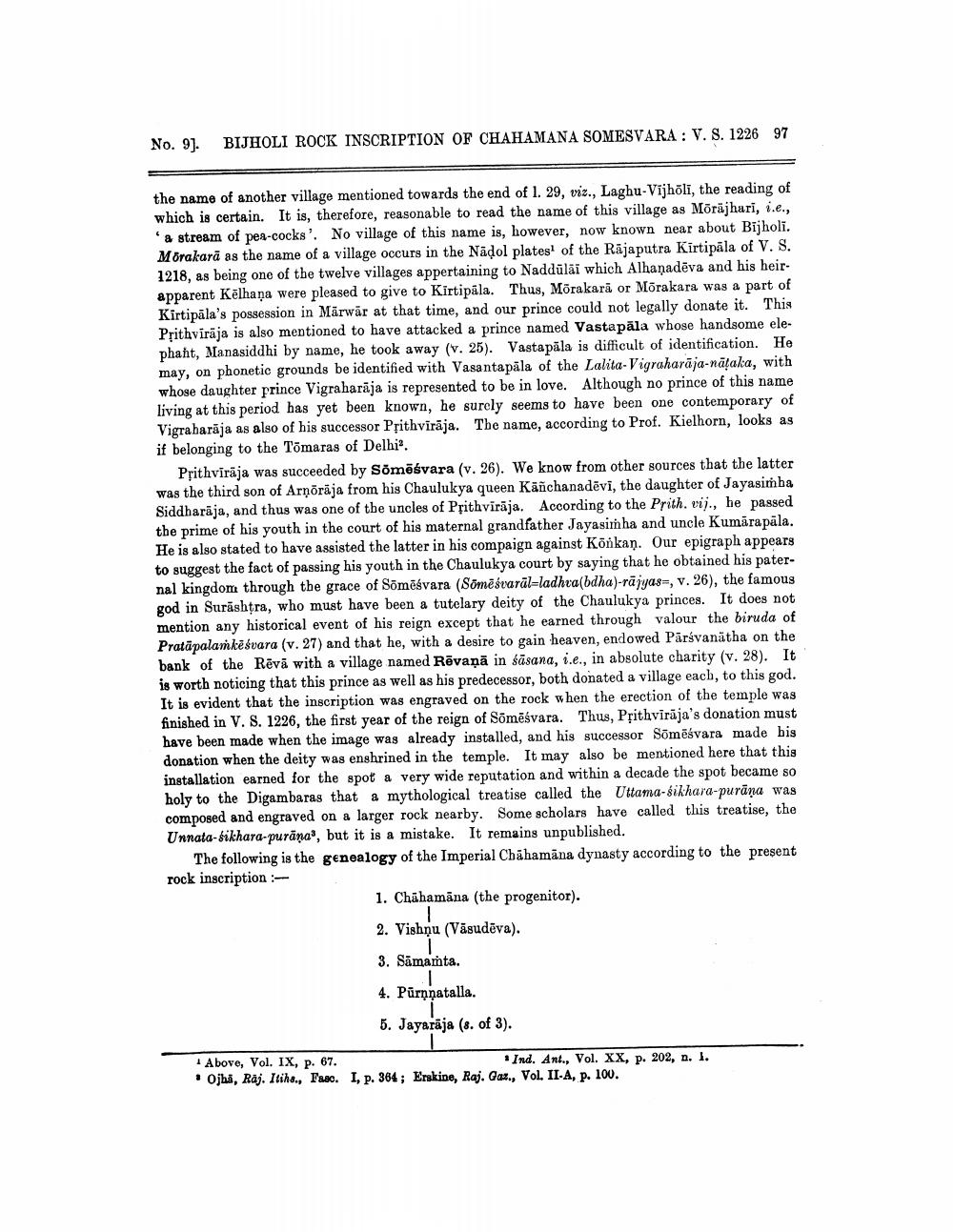________________
No. 9].
BIJHOLI ROCK INSCRIPTION OF CHAHAMANA SOMESVARA: V. S. 1226 97
the name of another village mentioned towards the end of 1. 29, viz., Laghu-Vijhōli, the reading of which is certain. It is, therefore, reasonable to read the name of this village as Möräjhari, i.e., ' a stream of pea-cocks'. No village of this name is, however, now known near about Bijholi. Mörakarā as the name of a village occurs in the Nãḍol plates1 of the Rajaputra Kirtipāla of V. S. 1218, as being one of the twelve villages appertaining to Naddūlai which Alhaṇadeva and his heirapparent Kelhaṇa were pleased to give to Kirtipāla. Thus, Mōrakarā or Mōrakara was a part of Kirtipāla's possession in Märwär at that time, and our prince could not legally donate it. This Prithviraja is also mentioned to have attacked a prince named Vastapāla whose handsome elephant, Manasiddhi by name, he took away (v. 25). Vastapala is difficult of identification. He may, on phonetic grounds be identified with Vasantapala of the Lalita-Vigraharaja-nataka, with whose daughter prince Vigraharaja is represented to be in love. Although no prince of this name living at this period has yet been known, he surely seems to have been one contemporary of Vigraharaja as also of his successor Prithviraja. The name, according to Prof. Kielhorn, looks as if belonging to the Tomaras of Delhi'.
Prithviraja was succeeded by Someśvara (v. 26). We know from other sources that the latter was the third son of Arņoraja from his Chaulukya queen Kanchanadevi, the daughter of Jayasimha Siddharaja, and thus was one of the uncles of Prithviraja. According to the Prith. vij., he passed the prime of his youth in the court of his maternal grandfather Jayasimha and uncle Kumarapala. He is also stated to have assisted the latter in his compaign against Kōnkan. Our epigraph appears to suggest the fact of passing his youth in the Chaulukya court by saying that he obtained his paternal kingdom through the grace of Somesvara (Somesvaral-ladhva(bdha)-rajyas-, v. 26), the famous god in Surashtra, who must have been a tutelary deity of the Chaulukya princes. It does not mention any historical event of his reign except that he earned through valour the biruda of Pratapalamkesvara (v. 27) and that he, with a desire to gain heaven, endowed Pärśvanätha on the bank of the Reva with a village named Rēvaṇā in śāsana, i.e., in absolute charity (v. 28). It is worth noticing that this prince as well as his predecessor, both donated a village each, to this god. It is evident that the inscription was engraved on the rock when the erection of the temple was finished in V. S. 1226, the first year of the reign of Sōmēśvara. Thus, Prithviraja's donation must have been made when the image was already installed, and his successor Sōmēśvara made his donation when the deity was enshrined in the temple. It may also be mentioned here that this installation earned for the spot a very wide reputation and within a decade the spot became so holy to the Digambaras that a mythological treatise called the Uttama-sikhara-purāna was composed and engraved on a larger rock nearby. Some scholars have called this treatise, the Unnata-sikhara-purana, but it is a mistake. It remains unpublished.
The following is the genealogy of the Imperial Chahamana dynasty according to the present rock inscription:--
1. Chāhamana (the progenitor).
1
2. Vishnu (Vasudeva).
3. Sāmamta.
I
4. Pūrṇnatalla.
5. Jayaraja (8. of 3).
Ind. Ant., Vol. XX, p. 202, n. 1.
Above, Vol. IX, p. 67.
Ojha, Raj. Itihs., Fasc. I, p. 364; Erskine, Raj. Gaz., Vol. II-A, p. 100.




